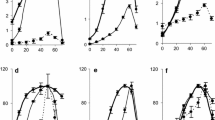Abstract
The enzymatic activity (expressed as milliunits per milligram total proteins) of three intestinal brush-border membrane enzymes, leucine aminopeptidase, alkaline phosphatase and maltase, measured over a range of temperatures between 1.5 and 37 °C, has been found to be much higher in the Antarctic fish Pagothenia bernacchii than in the temperate fish Anguilla anguilla. To explain this experimental observation the apparent Michaelis-Menten constant, the maximal velocity, the activation energy values and the thermal stability of these three enzymes were measured. The apparent Michaelis-Menten constant values of leucine amino peptidase and alkaline phosphatase were different in the intestine mucosal homogenate of the two fish at each measured temperature (from a minimum of 2.5 to a maximum of 37 °C). However, the values found at 2.5 °C for the Antarctic species and 15 °C for the eel where comparable. Furthermore, its value was unchanged in eel intestine apical membranes, both in the presence and without enzyme lipid microenvironment. While the maximal enzymatic activities of the leucine aminopeptidase and maltase did not decrease without their enzyme lipid microenvironment, produced by treatment with Triton X-100, the impairment of alkaline phosphatase maximal activity cannot be significantly differentiated from a non-specific inhibitory effect of the detergent. The activation energy values of leucine amino peptidase, alkaline phosphatase and maltase were lower in the Antarctic fish (11.7, 5.6 and 11.8 kcal·mol-1, respectively) than in the eel (13.6, 7.6 and 13.1 kcal·mol-1, respectively). The thermal stability of alkaline phosphatase and maltase is different in Pagothenia bernacchii and Anguilla anguilla intestinal homogenate.
Similar content being viewed by others
Abbreviations
- BBM:
-
brush border membrane
- E a :
-
activation energy
- EGTA:
-
ethyleneglycol-bis-(β-amino ethylether)N, N′-tetraacetic acid
- HEPES:
-
2-[4-(2-hydroxyethyl)-1-piperazinyl]-ethane sulphonic acid
- Kmapp :
-
apparent Michaelis-Menten constant
- PMSF:
-
phenylmethyl-sulphonyl fluoride
- TRIS:
-
TRIS (hydroxymethyl)-aminomethane
References
Berner W, Kinne R, Murer H (1976) Phosphate transport into brush-border membrane vesicles isolated from rat small intestine. Biochem J 160:467–474
Brasitus TA, Schachter D (1980) Lipid dynamics and lipid-protein interaction in rat enterocyte basolateral and microvillus membranes. Biochemistry 19:2763–2769
Clarke A (1987) The adaptation of aquatic animals to low temperatures. In: Grout, Morris (eds) The effect of low temperatures on biological systems pp 315–348
Feller G, Thiry M, Arpigny GL, Gerday C (1991a) Cloning and expression in Escherichia coli of three lipase-encoding genes from the psychrotrophic Antarctic strain Moraxella TA144. Gene 102:111–115
Feller G, Thiry M, Gerday C (1991b) Nucleotide sequence of the lipase gene lip2 from the Antarctic psychrotroph Moraxella TA144 and site-specific mutagenesis of the conserved serine and histidine residues. DNA Cell Biol 10:381–388
Genicot S, Feller G, Gerday C (1988) Trypsin from Antarctic fish (Paranothothenia magellanica Forster) as compared with trout (Salmo gairdneri) trypsin. Comp Biochem Physiol 90B:601–609
Haase W, Schaffer A, Murer H, Kinne R (1978) Studies on the orientation of the brush border membrane vesicles. Biochem J 172:57–62
Hazel JR, Prosser CL (1974) Molecular mechanisms of temperature compensation in poikiloterms. Physiol Rev 54:620–677
Hazel JR (1979) The influence of thermal acclimation on membrane lipid composition of rainbow trout liver. Am J Physiol 236:R91-R101
Higgins JA (1987) Separation and analysis of membrane lipid components. In: Findlay JBC, Evans WH (eds) Biological membranes: a practical approach. Irl Press, Oxford, pp 103–137
Hochachka PW, Somero GN (1984) Biochemical adaptation. Princeton University Press, Princeton, NJ, USA, pp 1–537
Johnston IA, Goldspink G (1975) Thermodynamic activation parameters of fish myofibrillar ATPase enzyme and evolutionary adaptations to temperature. Nature (London) 257:620–622
Johnston IA, Walesby NJ (1977) Molecular mechanisms of temperature adaptation in fish myofibrillar adenosine triphosphatases. J Comp Physiol 119:195–206
Low MG (1987) Biochemistry of the glycosyl-phosphatidylinositol membrane protein anchors. Biochem J 244:1–13
Macdonald JA (1981) Temperature compensation in the peripheral nervous system: Antarctic vs temperate poikiloterms. J Comp Physiol 142:411–418
Macdonald JA, Montgomery JC (1982) Thermal limits of neuromuscular function in an Antarctic fish. J Comp Physiol 147:237–250
Marquardt DW (1963) An algorithm for least squares estimation of a non-linear parameters. J Soc Ind Appl Math 11:431–441
Somero GN (1977) Temperature as a selective factor in protein evolution: the adaptational strategy of “compromise”. J Exp Zool 194:175–188
Somero GN (1991) Biochemical mechanisms of cold adaptation and stenothermality in Antarctic fish. In: Di Prisco B, Maresca B, Tota B (eds) Biology of Antarctic fish. Springer, Berlin Heidelberg New York, pp 232–247
Storelli C, Vilella S, Cassano G (1986) Na-dependent D-glucose and L-alanine transport in eel intestinal brush border membrane vesicles. Am J Physiol 251:R463-R469
Swezey RR, Somero GN (1982) Polymerisation thermodynamics and structural stability of skeletal muscle actins from vertebrates adapted to different temperatures and hydrostatic pressures. Biochemistry 21:4496–4503
Williams RC, Correia JJ (1985) Formation of microtubules at low temperature by tubulin from Antarctic fish. Biochemistry 24:2790–2798
Author information
Authors and Affiliations
Rights and permissions
About this article
Cite this article
Maffia, M., Acierno, R., Deceglie, G. et al. Adaptation of intestinal cell membrane enzymes to low temperatures in the Antarctic teleost Pagothenia bernacchii . J Comp Physiol B 163, 265–270 (1993). https://doi.org/10.1007/BF00347776
Accepted:
Issue Date:
DOI: https://doi.org/10.1007/BF00347776




